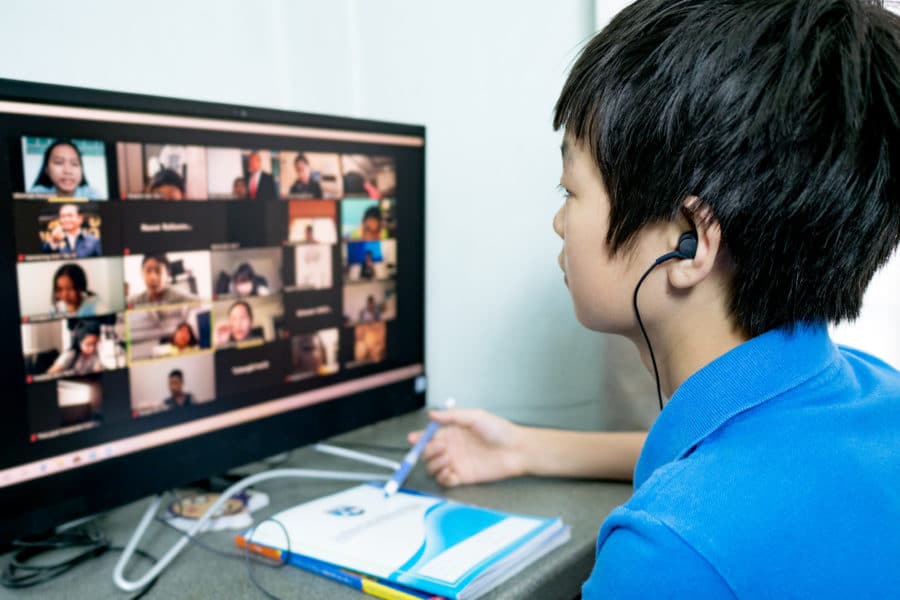
Class is the next generation virtual classroom for K-12, higher education, government agencies, and the workplace. Contact us today to schedule your live demo and see Class in action.

Class is the next generation virtual classroom for K-12, higher education, government agencies, and the workplace. Contact us today to schedule your live demo and see Class in action.

It’s impossible to predict the future, a lesson well-learned in the past year. As school systems at all levels around the world scrambled to come up with viable ways to ensure students could continue their educations, one thing became abundantly clear to IT leaders in education: the need to future-proof their school’s IT infrastructure.
Joe Sallustio is COO and EVP of Claremont Lincoln University, a school that offers master’s degree programs with a socially-conscious focus. He produces and hosts two education podcasts where he interviews leaders in the field. Sallustio believes that remote learning has changed education for the better. “Higher education has been long overdue for reform,” he says. The pandemic, he says, has caused an “awakening.” And, he adds: “Online learning is reshaping the landscape at every level, forcing innovation to accommodate varying modes of learning—synchronous, synchronous and hybrid.”
School systems with solid, and flexible, IT infrastructures were more able to quickly flex to serve students remotely than others. Those that weren’t had to quickly take steps to ensure both that their teachers could teach online—and that students could learn. When students are remote, the idea of infrastructure extends beyond schools’ physical structures. Students also must be equipped to learn remotely with the appropriate technology and tools.
Virtual learning heightened the need to be constantly vigilant and flexible and, to whatever extent possible, ensure that schools infrastructure are futureproof.
While many school systems were already heavily involved in ensuring a sound school IT infrastructure to meet current and projected needs, the pandemic has changed and, in many cases, expedited those plans.
With remote learning, school IT infrastructure is being tested in ways it never has been before. Schools, on an ongoing basis, need to ensure that their infrastructure is future-proof. That can be decidedly difficult to do with technology options changing regularly— with the industry constantly introducing new options from both a hardware and software standpoint. Students’ needs and access to technology are also constantly changing. Schools must find the balance between being cutting edge enough that they’re poised for the future, but not so cutting edge that they leave students—and teachers behind.
COVID-19 has brought many of these issues to the forefront, spurring discussions at all levels of education—as well as among parents and communities around the country.

One key area of concern for IT pros is safety and security, says Eric Florence, an IT professional who has been working with K-12 schools for years. “The pandemic has forced teachers and students to work from home via Zoom and online video streaming services, and I think this has introduced a number of specific safety concerns IT professionals need to be able to address,” he says. At a baseline, he says, IT teams must take stock of servers and networking gear in order to determine if their infrastructure can support the school’s network or if more capacity is needed for the long term.
“Likely we will continue to see schools invest in advanced networking equipment that will keep them protected for the long haul. From here we can start to look for more scalable IT solutions, because what we have now may not last long term remote learning,” Florence says.
Brock Glidwell is a former teacher who is now a school district IT administrator and (virtual Chief Information Officer (vCIO)) at Pearson-Kelly Technology, where he helps multiple school districts manage the repercussions of ongoing struggles they’re facing in response to virtual learning. He recommends that school district IT administrators:
One of the challenges that school systems have realized during virtual learning—and that they must work to continue to address and overcome in the future—are disparities in access to both hardware and wi-fi access for students in underserved areas, or in low-income settings.

Not all school systems are created equal, of course, and some have unique challenges. Mercy College, for instance, a private college with three campuses in the New York City metro area educates about 10,000 students, the majority (>65%) coming from households with annual income levels under $25,000. For these students, prior to the pandemic, computer access was more of a luxury than a necessity. Since the pandemic, though, the school has had to work hard to ensure students have the laptop and IT access they need. This has involved loaner computers and setting up special computer labs to provide access for students.
“There’s an increased focus on the work that must be done to support underserved populations, and more tangible steps are being taken to achieve educational equity such as access to technology and the internet,” says Sallustio.
While, despite important lessons learned during the pandemic, school systems can’t predict the future, there is one thing they can do—build and maintain relationships with key stakeholders.
“Schools should expect the continuation of remote teaching and learning for the foreseeable future,” says Florence. “I am always pressing IT professionals to have better communication with organizers within K-12 in order to provide the best online experience for our children.”
Ongoing communication and a focus on continuous improvement can help position school IT infrastructures for whatever the future may bring.

Class is the next generation virtual classroom for K-12, higher education, government agencies, and the workplace. Contact us today to schedule your live demo and see Class in action.

Class is the next generation virtual classroom for K-12, higher education, government agencies, and the workplace. Contact us today to schedule your live demo and see Class in action.
Get our insights, tips, and best practices delivered to your inbox

Sign up for a product demo today to learn how Class’s virtual classroom powers digital transformation at your organization.

Features
Products
Integrations